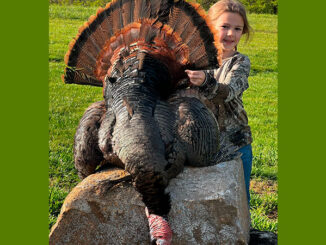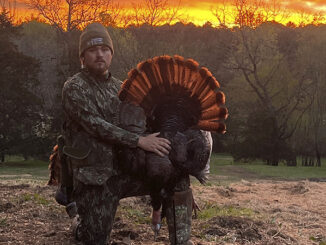
The smaller, the better. That’s how some trout fishermen look at North Carolina’s backcountry mountain streams.
Western North Carolina contains some of the most remote places east of the Mississippi River, with absolutely breathtaking views from every angle. The mountains are full of steep ridges, deep canyons and are covered in century-old forests, a true wilderness.
Just about everywhere these hills collide creates tributaries with pristine character and thriving aquatic life. And for the adventurous angler able to leave the luxuries of civilization miles away, excellent fishing opportunities lies in the backcountry for wild trout.
To some, backcountry areas are city parks with paved trails and wooden playgrounds or places away from the city where fields of corn and cattle roam. But true wilderness is remote and away from the evidence of man. In the Wilderness Act of 1964, Congress defined wilderness as an area where the earth and its community of life are untrammeled by man, where man himself is a visitor who does not remain.
That accurately describes much of North Carolina’s western mountains — vast areas of raw land untouched by extensive development and significant human interference. While a large portion of this land contains vertical cliff faces, canyons and steep ridges too difficult for anyone to develop and pave, most of this land is under federal ownership in the Great Smoky Mountain National Park, the Nantahala National Forest or the Pisgah National Forest. Hundreds of thousands of acres of public lands are available to explore that are crisscrossed with seemingly endless rivers and streams loaded with all species of trout: rainbow, brown and native brook trout.
For an angler in search of true solitude and a good day with a fly rod needs to visit North Carolina’s backcountry, well off the beaten path, and spring is the perfect time to take a hike.
Guide Jason Cole of Hooker’s Fly Shop in Sylva looks forward to the arrival of each spring.
“May is a top month to trout fish in the North Carolina mountains,” said Cole. “The water is warming up, and the hatches are prolific, making the fish very active. You can use several different fly patterns and catch fish.”
During the spring, warming waters set the stage for many species of aquatic insects to start doing their thing. Anglers can use a wide variety of mayfly, caddis fly, and stonefly patterns because of all of the hatching insects.
But, anglers become very active as well, and the easily-accessible waters close to the blacktop frequently get heavy fishing pressure in spring. Cole welcomes those fishermen, but when time allows, he he fishes backcountry places less frequented by the casual angler.
“We take extended day trips and multi-day trips into the backcountry to access the less-disturbed fish,” says Cole.
One of the overnight trips is to remote sections of Hazel and Forney creeks in the Great Smoky Mountain National Park on the north side of Fontana Lake in Swain County. Anglers are ferried to the Hazel Creek trailhead via boats from Fontana Marina, headed for five designated backcountry campsites along Hazel Creek and six along Forney Creek. In order to claim a night at one of these campsites, a reservation must be made no more than 30 days from the time you plan to camp.
For Cole, these creeks are some of the most remote waters in the park that have very good fishing opportunities.
“All of Hazel and Forney are wild-trout populations, and we catch some real nice fish in these drainages. It is not unusual to catch fish from 13 to 16 inches, and I even caught a 23 incher a few years back on an overnight trip,” he said.
While some big, trophy trout will rise to a dry fly on a beautiful spring day, most wild trout in the backcountry are less than 12 inches long and only distant cousins of the fish raised in hatcheries and stocked in waters closer to civilization.
Guide Jeff Curtis of Curtis Wright Outfitters in Weaverville explains the difference between fish available in hatchery-supported waters and wild fish available in remote waterways deep in the wilderness.
“Wild fish in these headwater creeks aren’t used to seeing anglers at all. They are very weary in the backcountry, always on the lookout for predators from above,” said Curtis. “Be stealthier, crouch down when needed and watch your silhouette.”
Still, targeting wild fish can be very rewarding when miles away from civilization. Stealthy tactics will always give anglers an advantage, and when using the right temptation, a rise from a fish is not a problem.
“Because these creeks are so remote, they can still be technical and challenging to catch,” says Curtis.
However, trout will be more than willing to eat something they are accustomed to seeing in these wild waters.
“Backcountry fishing is technical fishing because the fish are not as gullible as the stocked fish in the more accessible drainages,” said Cole, who said fish from hatcheries are accustomed to routine disturbance from roadside anglers. Wild trout are aware of airborne predators, but their are primarily watching for critters to fill their bellies floating downstream or in the surface film.
Learning how to be observant of what is hatching is Cole’s best streamside advice.
“Matching the hatch is something I pay close attention to on wild trout. You need to be fairly close to what is hatching to participate effectively,” he said.
Trout consume a wide variety of insects during spring, from several species of mayflies, stoneflies and caddis flies to a few terrestrial patterns that are present in streams after heavy rains. Both Cole and Curtis carefully select their flies from what they believe the fish are eating. And since backcountry trips are far, far from a truck, a wide selection of flies in various sizes is critical.
Cole packs flies including imitations of little Yellow Stoneflies, Sulfurs, Light Cahills, March Browns, Golden Stones and even some caddis imitations. He will also use a dry-dropper rig frequently with a nymph like a Pheasant Tail, Hare’s Ear, or Copper John dangling below.
“I will use a dry-dropper any time of year,” he said.
Curtis will use a variety of patterns in the backcountry that resemble insects that are coming off in spring. He is primarily a dry-fly fisherman and will use almost entirely dries in yellow and tan colorations. He likes to use patterns that he can see well, too.
“If I am fishing the backcountry, I will fish a split-winged Thunderhead, yellow Stimulator, or a female Parachute Adams. These flies will imitate about anything that will be coming off in May,” he said.
The national park and national forests offer endless backcountry opportunities for ambitious anglers. A few of Cole’s favorites are: Mull Creek, Beech Flat Creek, Rough Butt Creek, Tiny Mountain Creek, Straight Fork Creek, Enloe Creek and the upper reaches of Cane Fork on U.S. Forest Service land.
Curtis fishes creeks all over Pisgah National Forest and many drainages in the park.
“Two of my favorite backcountry wild streams are the headwaters of the South Toe River in Pisgah and the upper Davidson River beyond the hatchery. But Palmer Creek in the Cataloochee Valley is truly exceptional, and the further up you go from the valley itself, the better the fishing is,” he said.
DESTINATION INFORMATION
HOW TO GET THERE — Western North Carolina features more than 3,000 miles of trout waters, with many streams only accessible from trailheads or crossings with public thoroughfares in the Great Smoky Mountains National Park, the Nantahala National Forest and the Pisgah National Forest. But trout waters begin just west of Hickory and extend to the Tennessee border.
WHEN TO GO — Spring insect hatches that attract trout will begin and March and last into the summer. Destination Information. From late April through June, fishermen will see the highest level of aquatic insect activity that’s ideal for fishing backcountry, tributary waters where fish will be feeding heavily.
BEST TECHNIQUES — Spring is the perfect time of year to go with dry flies, with aquatic insect hatches prevalent in many backcountry streams; mayflies, caddis flies and stoneflies are hatching every day. Try to eliminate false casting, crouch down and make short, strategic casts. Your fly box should have plenty of Light Cahills (tan and gray), Sulfurs, Yellow Attractors, Parachute Adams, Irresistibles, Adams, Royal Wulff, March Browns, and Golden Stones in Nos. 12 through 16. Keep flies riding high on surface film by using floatants. A dropper nymph can be added to entice fish feeding below the surface. Long casts are not required, so 7 1/2- to 8 1/2-foot, 4-weight rods and 7 1/2-foot, 5X tippets.
FISHING INFO/GUIDES — Jason Cole, Hooker’s Fly Shop, Sylva, 828-587-4665, www.hookersflyshops.com; Jeff Curtis, Curtis Wright Outfitters, Weaverville, 828-646-8700, www.curtiswrightoutfitters.com.
ACCOMMODATIONS — Lands Creek has cabins along the Great Smoky Mountain National Park with close access to area waters, 828-346-9793, www.landscreek.com; Swain County Chamber of Commerce, www.GreatSmokiesFishing.com; The Official Travel & Tourism Website for North Carolina (www.visitnc.com).
MAPS — DeLorme’s North Carolina Atlas & Gazetteer, 207-846-7000, www.delorme.com; N.C. Wildlife Resources Commission, www.ncwildlife.org/Fishing/TroutFishingMaps.aspx; Great Smoky Mountains National Park, 865-436-1200, www.nps.gov.









Be the first to comment